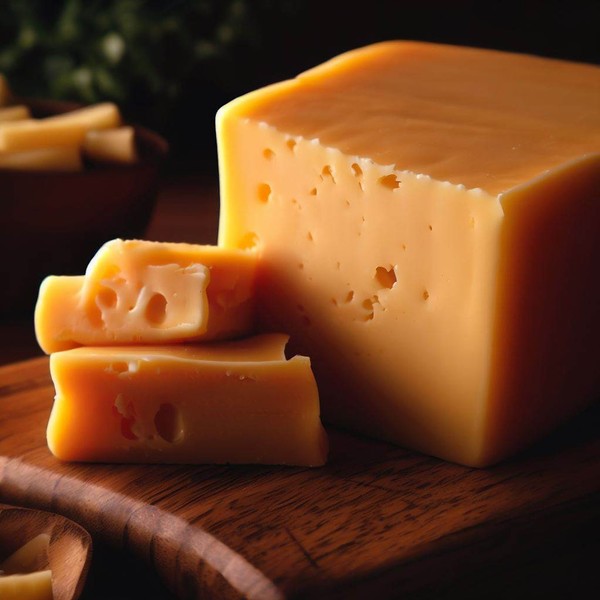Cheddar Cheese

Indulge in the art of homemade cheese making with our tantalizing recipe for cheddar cheese. Discover the joy of crafting your own creamy, flavorful blocks of cheddar right in your kitchen. With a handful of simple ingredients and a dash of patience, you'll soon be savoring the satisfaction of creating a delectable masterpiece that will impress even the most discerning cheese connoisseurs.
Marthinus StrydomThe Story
Originating from the quaint English village of Cheddar in Somerset, Cheddar cheese has a rich and fascinating history that spans centuries. Its roots can be traced back to the late 12th century, making it one of the oldest and most beloved cheeses in the world.
Legend has it that Cheddar cheese was accidentally discovered when a local milkmaid forgot about a pail of milk in the caves of Cheddar Gorge. The unique microclimate and conditions within the caves contributed to the transformation of the milk into a firm, flavorful cheese. This happy accident sparked the birth of a cheese-making tradition that would endure for generations.
In the early days, Cheddar cheese was primarily made by farmstead producers using milk from their own cows. It was a way of preserving surplus milk and creating a shelf-stable product that could be enjoyed throughout the year. The process involved heating the milk, adding rennet to coagulate it, and then cutting and stacking the curds to expel whey. The curds were pressed into forms, salted, and aged to develop the characteristic tangy flavor and crumbly texture.
As time went on, Cheddar cheese gained popularity and started being produced on a larger scale. The Industrial Revolution in the 18th century played a significant role in its mass production and distribution. Innovations such as the introduction of cheese presses and the invention of cheese factories streamlined the production process and allowed for greater consistency in flavor and texture.
Cheddar cheese crossed the Atlantic during the 19th century as British immigrants brought their cheese-making traditions to North America. The United States and Canada became major producers of Cheddar, with regional variations and adaptations emerging over time. Today, Cheddar cheese is enjoyed worldwide, both in its traditional form and in various flavored and aged variations.
From its humble beginnings in a village cave to its global popularity, Cheddar cheese remains a timeless favorite cherished for its versatility, distinct taste, and historical significance. Whether grated on top of a warm bowl of macaroni and cheese or enjoyed as a simple slice in a sandwich, Cheddar cheese continues to delight palates and remind us of the rich heritage behind this iconic cheese.
More about United Kingdom
The United Kingdom, made up of England, Scotland, Wales and Northern Ireland, is an island nation in northwestern Europe. England – birthplace of Shakespeare and The Beatles – is home to the capital, London, a globally influential centre of finance and culture. England is also site of Neolithic Stonehenge, Bath’s Roman spa and centuries-old universities at Oxford and Cambridge.

Subscripe to my Facebook page.
Subscripe to my Youtube channel.
© All recipes are copyright protected by TheCultureCook.com unless the recipe was adapated from another source. All recipes are uniquely crafted and adapted by TheCultureCook.com. Copyright of some or all of the text reside with the original author.
Ingredients
Method
- Heat milk to 31°C.
- Add Mesophilic culture and allow it to ripen for 40 minutes.
- Add Calcium Chloride to the milk.
- Add Rennet and wait for 40 minutes.
- Check for a clean break in the curd.
- Cut the curd into 1.25cm cubes.
- Allow the curds to heal for 5 minutes.
- Increase the temperature gradually to 39°C over 45 minutes while stirring gently.
- Let the curds settle for 40 minutes.
- Drain the curds in cheesecloth.
- Place the curds in a pot and cut them in half.
- Let the curds rest for 10 minutes.
- Turn each curd half and let them rest for another 10 minutes while maintaining a temperature of 39°C.
- Repeat the turning process for each curd half, allowing them to rest for 10 minutes each time.
- After the final turn, let the curds rest for 15 minutes.
- Drain the curd slabs and cut them into 1.25cm cubes.
- Break the curds into halves.
- Mix in the salt in three steps over a span of 15 minutes.
- Add the curds to a cheese mold.
- Press the curds at 11kg of weight for 1 hour.
- Increase the weight to 22kg and continue pressing for 12 hours.
- Air dry the cheese for 2-3 days.
- Place the cheese in a cheese cave for 1 month, or alternatively, vacuum seal it immediately after drying.
